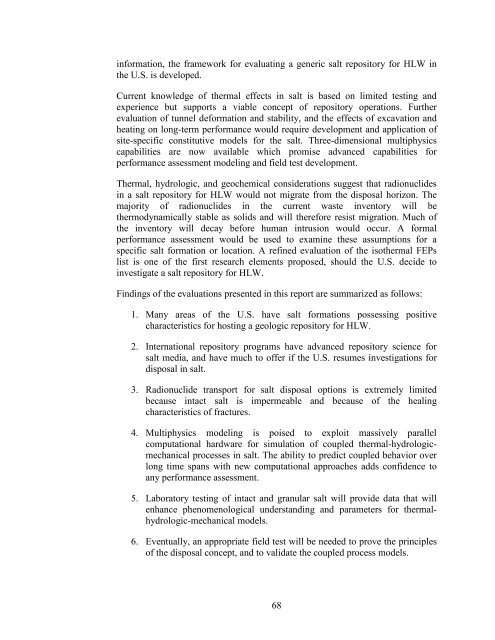Salt Disposal of Heat-Generating Nuclear Waste
Salt Disposal of Heat-Generating Nuclear Waste
Salt Disposal of Heat-Generating Nuclear Waste
Create successful ePaper yourself
Turn your PDF publications into a flip-book with our unique Google optimized e-Paper software.
information, the framework for evaluating a generic salt repository for HLW in<br />
the U.S. is developed.<br />
Current knowledge <strong>of</strong> thermal effects in salt is based on limited testing and<br />
experience but supports a viable concept <strong>of</strong> repository operations. Further<br />
evaluation <strong>of</strong> tunnel deformation and stability, and the effects <strong>of</strong> excavation and<br />
heating on long-term performance would require development and application <strong>of</strong><br />
site-specific constitutive models for the salt. Three-dimensional multiphysics<br />
capabilities are now available which promise advanced capabilities for<br />
performance assessment modeling and field test development.<br />
Thermal, hydrologic, and geochemical considerations suggest that radionuclides<br />
in a salt repository for HLW would not migrate from the disposal horizon. The<br />
majority <strong>of</strong> radionuclides in the current waste inventory will be<br />
thermodynamically stable as solids and will therefore resist migration. Much <strong>of</strong><br />
the inventory will decay before human intrusion would occur. A formal<br />
performance assessment would be used to examine these assumptions for a<br />
specific salt formation or location. A refined evaluation <strong>of</strong> the isothermal FEPs<br />
list is one <strong>of</strong> the first research elements proposed, should the U.S. decide to<br />
investigate a salt repository for HLW.<br />
Findings <strong>of</strong> the evaluations presented in this report are summarized as follows:<br />
1. Many areas <strong>of</strong> the U.S. have salt formations possessing positive<br />
characteristics for hosting a geologic repository for HLW.<br />
2. International repository programs have advanced repository science for<br />
salt media, and have much to <strong>of</strong>fer if the U.S. resumes investigations for<br />
disposal in salt.<br />
3. Radionuclide transport for salt disposal options is extremely limited<br />
because intact salt is impermeable and because <strong>of</strong> the healing<br />
characteristics <strong>of</strong> fractures.<br />
4. Multiphysics modeling is poised to exploit massively parallel<br />
computational hardware for simulation <strong>of</strong> coupled thermal-hydrologicmechanical<br />
processes in salt. The ability to predict coupled behavior over<br />
long time spans with new computational approaches adds confidence to<br />
any performance assessment.<br />
5. Laboratory testing <strong>of</strong> intact and granular salt will provide data that will<br />
enhance phenomenological understanding and parameters for thermalhydrologic-mechanical<br />
models.<br />
6. Eventually, an appropriate field test will be needed to prove the principles<br />
<strong>of</strong> the disposal concept, and to validate the coupled process models.<br />
68
















